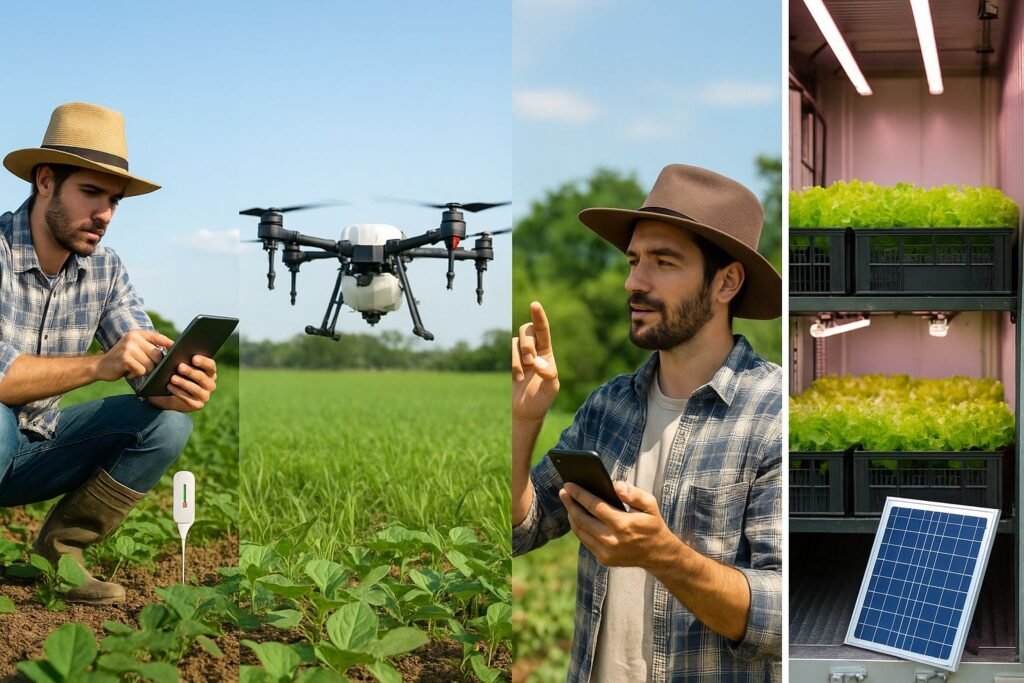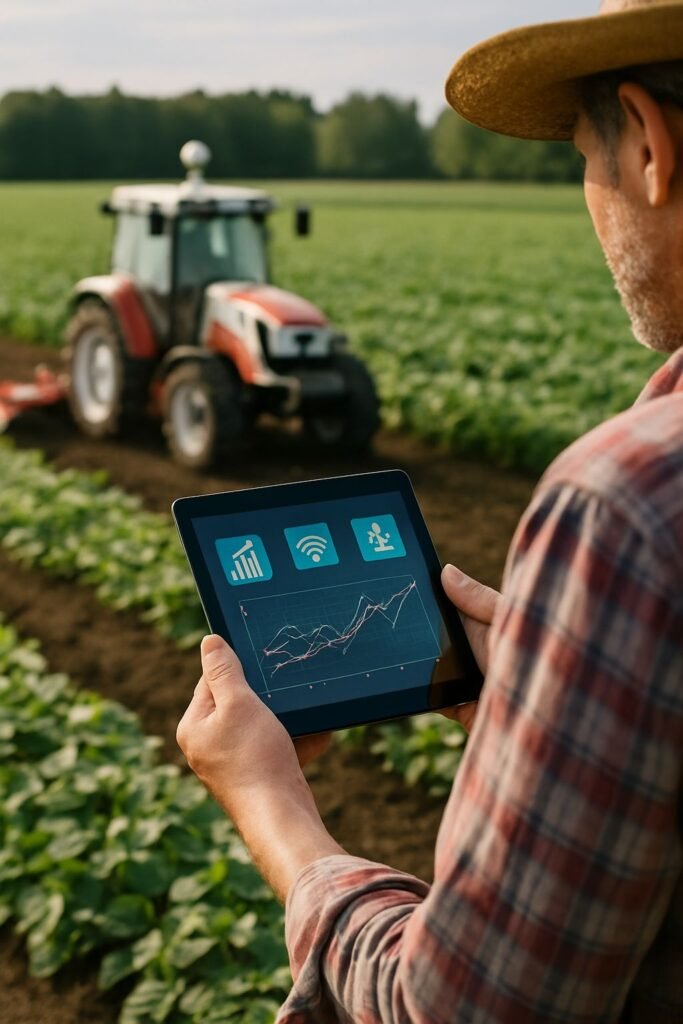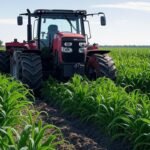
🌾 Introduction: How Smart Farming Technologies Are Giving Small Farms a Big Advantage
In today’s fast-changing agricultural landscape, smallholder farmers in Western countries face enormous pressure to produce more food with fewer resources, all while staying profitable and sustainable. Whether you’re managing 5 acres in Oregon or 20 in rural France, the need to innovate has never been more critical. The good news? Thanks to the rise of smart farming technologies, small farms can now leverage tools that were once only accessible to industrial operations. With affordable IoT devices, data-driven decision-making tools, and clean energy solutions, smallholders are becoming more productive, climate-resilient, and market-savvy.
This guide explores 10 powerful smart farming technologies — each with rationale, recent stats, and a simple breakdown of how it works — to help smallholder farmers in the West grow smarter.
🔢 Technology Overview Table
| Technology Name | Best For |
|---|---|
| Precision Soil Monitoring Devices | Optimizing fertilizer & water usage |
| Smart Irrigation Systems | Efficient water management & drought protection |
| Drone Technology for Monitoring & Pest Control | Fast crop scouting & precise pest detection |
| Mobile Farm Management Apps | Digital record-keeping & smarter planning |
| Automated Mini Tractors & Implements | Cost-effective fieldwork on small plots |
| Solar-Powered Irrigation & Cold Storage | Energy-saving water pumping & produce preservation |
| Biological Pest Control via Drones | Eco-friendly pest control for organic or low-chemical farming |
| Vertical Farming Units (Indoor Containers) | Urban or land-limited year-round crop production |
| Blockchain for Traceability & Co-op Mgmt | Building trust & accessing premium markets |
| Carbon Farming & Regenerative Tools | Earning carbon credits & improving soil health |
1. Precision Soil Monitoring Devices
🎯 Rationality:
Healthy soil is the foundation of sustainable farming. Real-time insights into soil health help reduce fertilizer waste, optimize water use, and improve yields — all while minimizing environmental impact.
⚙️ How It Works:
In-ground sensors measure moisture, pH, temperature, and nutrients. Data is transmitted via Wi-Fi or cellular networks to a mobile app, where farmers receive alerts and actionable insights.
Data Point: Farms using real-time soil sensors saw up to 20% higher crop productivity and 30% water use reduction (FAO, 2023).
Top Tools: Teralytic, Arable Mark, CropX.
2. Smart Irrigation Systems for Small Farms
🎯 Rationality:
Water is increasingly scarce. Smart irrigation ensures crops get exactly the water they need, reducing waste and protecting yields during drought.
⚙️ How It Works:
Connected to soil sensors and local weather data, smart irrigation systems automatically adjust water output through drip or sprinkler systems based on real-time conditions.
Research: Smart irrigation can reduce water usage by up to 50% while increasing crop yields by 15% (USDA, 2023).
Top Tools: Netafim, Rachio, Jain Irrigation Systems.
3. Drone Technology for Crop Monitoring and Pest Control
🎯 Rationality:
Manual crop scouting is time-consuming and imprecise. Drones provide fast, high-resolution insights into crop health, pests, and disease.
⚙️ How It Works:
Drones with HD or multispectral cameras scan fields. Software analyzes the imagery to detect crop stress, pest hotspots, or nutrient issues. Some drones can apply treatments directly.
Stat: Drone-enabled crop monitoring improves scouting efficiency by up to 75% (AgFunder, 2024).
Top Tools: DJI Agras, Parrot Bluegrass, XAG drones.
4. Mobile Farm Management Apps for Smarter Decisions
🎯 Rationality:
Smallholders wear many hats. Digital tools streamline record-keeping, reduce errors, and improve planning and compliance.
⚙️ How It Works:
Farmers log data such as planting schedules, input usage, harvest logs, and finances into a centralized mobile platform. Many apps offer AI-driven suggestions based on the farm’s crop type and region.
Insight: Over 68% of North American smallholders use mobile apps to manage their operations (Statista, 2024).
Top Apps: FarmLogs, Tend, AgriApp, CropSafe.
5. Automated Mini Tractors and Smart Implements
🎯 Rationality:
Labor shortages and small plots make large machinery impractical. Automated compact equipment fills the gap.
⚙️ How It Works:
Small electric or hybrid tractors use GPS navigation and automation software to handle seeding, weeding, or spraying with minimal oversight. Many can be remotely controlled by smartphone.
Trend: Mechanization reduces labor dependency and increases planting accuracy by up to 40% (AgriTech Europe, 2024).

Top Solutions: Kubota LX Series, Agxeed, FarmDroid FD20.
6. Solar-Powered Irrigation & Cold Storage Systems
🎯 Rationality:
Energy is expensive, especially in rural or off-grid areas. Solar systems cut fuel costs and reduce post-harvest losses.
⚙️ How It Works:
Solar panels power water pumps or refrigeration units. These systems often include batteries to ensure operation during cloudy periods or nighttime.
Fact: Solar cold rooms can reduce spoilage by up to 80% and increase income by 25% (World Bank, 2023).
Top Solutions: SunCulture, EcoZen, Simusolar.
7. Biological Pest Control via Agricultural Drones
🎯 Rationality:
Chemical pesticides harm ecosystems and face growing restrictions. Biological control is safer and consumer-friendly.
⚙️ How It Works:
Drones release beneficial insects like ladybugs or parasitoid wasps over crop areas. These insects naturally target and reduce pest populations.
Adoption: Over 36% of small organic farms in the USA now use biological pest control (OTA, 2023).
Top Tech: Parabug drones, BioBee solutions.
8. Vertical Farming Units for Space-Saving Solutions
🎯 Rationality:
Urban sprawl limits land access. Vertical farming allows year-round production in compact, climate-controlled environments.
⚙️ How It Works:
Plants grow in stacked layers using hydroponic or aeroponic systems with LED lighting. Sensors control temperature, light, and nutrients for optimal growth.
Productivity: A single container can produce up to 13,000 plants monthly, using 95% less water than traditional farming (Square Roots, 2023).
Top Providers: Freight Farms, Square Roots, InFarm.
9. Blockchain for Traceability and Co-op Management
🎯 Rationality:
Consumers and buyers want proof of sustainability and quality. Blockchain ensures traceability and fair trade.
⚙️ How It Works:
Transactions and production steps are recorded in a digital ledger. This builds trust with consumers, streamlines certifications, and opens premium markets.
Consumer trend: People are willing to pay 11% more for blockchain-verified food (IBM Food Trust, 2024).
Top Platforms: AgUnity, GrainChain, OriginTrail.
10. Carbon Farming & Regenerative Agriculture Tools
🎯 Rationality:
Climate policy is rewarding carbon-sequestering practices. Smallholders can monetize soil health improvements.
⚙️ How It Works:
Digital tools measure soil carbon and ecosystem health. Farmers use regenerative practices, and verified results can earn carbon credits or subsidies.
Funding Alert: The EU has pledged €20 billion to support carbon farming by 2030. Similar programs are emerging in the US and Canada.
Top Tools: Yard Stick, Biome Makers, Soil Metrics.
🔺 Conclusion: A New Era of Smart Farming Technologies for Smallholders
Smart farming technologies are no longer about size — they’re about strategy. These innovations give smallholder farmers the tools to thrive in a data-driven, eco-conscious future. By embracing innovation, small farms can boost productivity, reduce costs, and open up new market opportunities.
💡 Technology won’t replace farmers — but it will empower those who embrace it.



